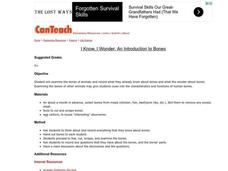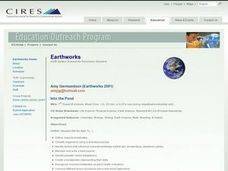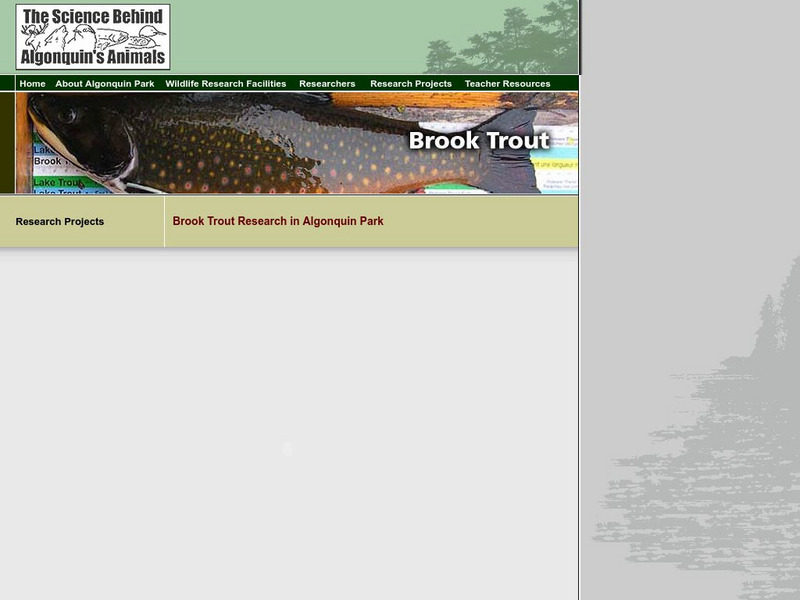Curated OER
Lead Detection
Students hypothesize whether the soil sample may have lead contamination and why. They describe what they see happening with the soil samples and the corresponding swabs. Pupils write a brief description of what they observe as the...
Curated OER
I Know, I Wonder: An Introduction to Bones
Fifth graders examine the bones of animals and record what they know and what they wonder about bones.
Curated OER
Is There Seaweed/Algae in Your Food?
Students discover that seaweed/algae is a small part of the resources the oceans provide. By investigating common household products, students discover that human senses are not enough to detect the presence of seaweed/algae in food.
Curated OER
The Party: Friend or Enemy of Democracy
Students recognize and appreciate the paradox between an MP being able to vote according to the wishes of their constituents and / or their conscience versus voting according to party line. The class conducts a simulated vote.
Curated OER
Into the Pond
Seventh graders use a pond to explore macroinvertebrates and other organisms. They use a dichotomous key to classify the organisms and maintain a journal recording their findings.
Curated OER
Artifact Ethics
Fourth graders examine their own values and beliefs about archaeological site protection and evaluate possible actions they might take regarding site and artifact protection.
Curated OER
Chesapeake Bay Population Studies
Students determine how to use a quarter meter quadrant to find population density, relative density, frequency and how to calculate a diversity index while participating in a virtual field trip. They study how to establish a Correlation...
Curated OER
Understanding Estuaries
Students work together to develop their own estuarine ecosystem in an aquarium. They observe the aquarium daily and record them in a notebook. They discuss the different interactions they see with the class.
Curated OER
Aquarium Journals
Fifth graders keep journals of observations made about their Aquademics aquarium. Using a worksheet, they record information such as tank water temperature, feeding times, ammonia and pH levels, and unusual behaviors. Journals can be...
Curated OER
Ohlone Indians
Fourth graders use various pictures to identify the economic activities, food supply or religious beliefs of the Ohlone Indians. Students create a cooperative learning travel brochure.
Curated OER
Zebrafish as a Model for Muscle Development
Young scholars explore the steps of protein synthesis in zebrafish. They view video clips to identify the parts of a zebrafish and observe them as they sequence the developmental stages. In groups they identify the muscles and how...
Curated OER
Computer Science: Pendulum
Learners investigate the basic properties of pendulums as a function of spreadsheets. Working in groups, they measure the period for a pendulum at six different lengths and record the results. They prepare a file using Microsoft Excel...
Curated OER
Parliamentary 101 or "How to Get Things Done!" (Unless You're in Opposition)
Students are introduced to new vocabulary used in a Legislature setting. As a class, they are divided into a Government group and an Opposition group and present their issues to the other side. They rank the issues and change roles to...
Curated OER
Oklahoma Ag in the Classroom
Learners read a recipe of beef jerky and explore the process. In this agriculture recipe lesson plan, students read the process and recipe for creating beef jerky. Learners also read a history of the American Plains Indians and their use...
Sea World Parks & Entertainment
Sea World: Bony Fish Diet and Eating Habits
This site provides a general rundown of the diet and eating habits of bony fish. Content includes a focus on food preferences and resources, food intake, methods of collecting and eating food, and fish as biological control agents.
National Geographic
National Geographic: Fisheries
In this lesson, students explore issues related to fisheries sustainability and simulate fish monitoring methods commonly used by scientists and resource managers.
National Geographic
National Geographic: Coral Reef Fish Survey Simulation
Students will learn surveying methods for an ecosystem through a short video. The video focuses on exploring the number and types of fish and the health of the coral reef ecosystem. Site includes a lesson plan and activity worksheet.
Science Education Resource Center at Carleton College
Serc: Lab 6: And on His Farm He Had Some Fish
A lab experiment in a series of experiments that investigates fisheries. In this particular lab, students learn about the aquaculture methods by analyzing FAO aquaculture data. They will also investigate the change to coastal landscapes...
TED Talks
Ted: Ted Ed: How I Fell in Love With a Fish
Chef Dan Barber squares off with a dilemma facing many chefs today: how to keep fish on the menu. With impeccable research and deadpan humor, he chronicles his pursuit of a sustainable fish he could love and the foodie's honeymoon he's...
Better Lesson
Better Lesson: The Fishing Trip
What good fishing trip isn't without a good story or two? Today the students will solve comparison story problems involving different lengths of fish.
Khan Academy
Khan Academy: Covered Jar With Fish in Lotus Pond
This piece, from the Avery Brundage Collection of the Asian Art Museum in San Francisco, illustrates a method of polychrome decoration in which painting, as well as firing, occurred twice: preceding glaze and over previously fired glaze....
Other
North Dakota Game and Fish Department: Small Game Hunting Guide
A detailed guide of regulations for hunting various small game in North Dakota. Covers seasons, hunting methods, animal identification, federal laws, poacher reporting, and much more. Each type of small game is accompanied by a map...
National Council of Teachers of Mathematics
Nctm: Figure This: How Many Fish in the Pond?
Can you figure out how many fish are in a pond? Use the statistical method of capture-recapture and estimation to solve this math challenge. An investigation from the NCTM Math Challenges for Families series. Discover how this skill can...
Friends of Algonquin Park
The Science Behind Algonquin's Animals: Brook Trout Research
It is a difficult job to determine the population of fish in a lake. Using a mark-recapture method gives researchers an accurate estimate of the fish population in a lake. As a researcher, your job at this activity, is to capture Brook...























